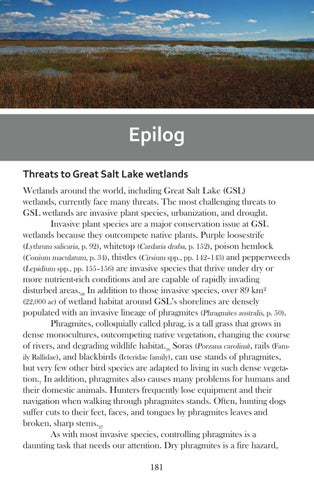Epilog Threats to Great Salt Lake wetlands
Wetlands around the world, including Great Salt Lake (GSL) wetlands, currently face many threats. The most challenging threats to GSL wetlands are invasive plant species, urbanization, and drought. Invasive plant species are a major conservation issue at GSL wetlands because they outcompete native plants. Purple loosestrife (Lythrum salicaria, p. 92), whitetop (Cardaria draba, p. 152), poison hemlock (Conium maculatum, p. 34), thistles (Cirsium spp., pp. 142–143) and pepperweeds (Lepidium spp., pp. 155–156) are invasive species that thrive under dry or more nutrient-rich conditions and are capable of rapidly invading disturbed areas.68 In addition to those invasive species, over 89 km² (22,000 ac) of wetland habitat around GSL’s shorelines are densely populated with an invasive lineage of phragmites (Phragmites australis, p. 50). Phragmites, colloquially called phrag, is a tall grass that grows in dense monocultures, outcompeting native vegetation, changing the course of rivers, and degrading wildlife habitat.30 Soras (Porzana carolina), rails (Family Rallidae), and blackbirds (Icteridae family), can use stands of phragmites, but very few other bird species are adapted to living in such dense vegetation.7 In addition, phragmites also causes many problems for humans and their domestic animals. Hunters frequently lose equipment and their navigation when walking through phragmites stands. Often, hunting dogs suffer cuts to their feet, faces, and tongues by phragmites leaves and broken, sharp stems.27 As with most invasive species, controlling phragmites is a daunting task that needs our attention. Dry phragmites is a fire hazard, 181









